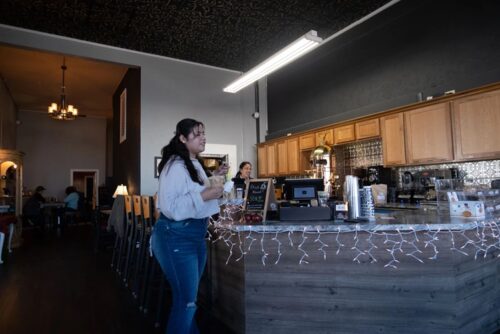
12.12.23 – KCUR –
Using AI-powered foot traffic software, officials in Seward, Finney and Ford counties now can track when people come to town and where they shop through anonymous cell phone data. That gives them information they can use to help local business owners and towns.
Communities in western Kansas are trying a new AI tool to help them target economic growth and hopefully fight long-term trends of population loss.
AI is doing everything from making art to writing computer software, and now community leaders in western Kansas are hoping it can help them crack the code for bringing people and businesses to their areas.
The rural communities are turning to AI to identify the businesses, services and housing residents need. That helps them target the types of businesses they should work to attract and where housing is needed to buck long-term trends of rural population loss.
It’s an intriguing idea to Shandon Classen. He sips coffee in the corner booth of his coffee shop in downtown Liberal, Kansas. He opened it last year. It’s the only locally owned coffee shop in town, but business has been difficult to maintain.
Using AI-powered foot traffic software, officials in Seward, Finney and Ford counties now can track when people come to town and where they shop through anonymous cell phone data. That gives them information they can use to help local business owners and towns.
Businesses like his will soon have access to the tool.
“If AI could tell us about our demographics, if it could help us know what people want, that would be a huge help,” Classen said.

The goal is finding out what people in a western Kansas town need.
Just down the road in Liberal, Mario Loredo is the type of person communities are hoping to learn about. He said his parents own a restaurant and frequently travel over 50 miles to Garden City to shop.
“They have to go to Garden, to Sam’s Club because they have to buy a lot of stuff in bulk,” Loredo said. “It’s just stuff you can’t find here.”
Loredo is one of many residents who travel to Garden City, the retail center in southwest Kansas. Garden City has seen more success in economic development than neighboring towns, but the hope is the community will continue expanding.
Lona Duvall is president of economic development for Finney County, home of Garden City. People like her have been trying to track out-of-town retail shoppers for years, but it hasn’t been easy. They only have a small staff and they’d have to physically look at license plates in shopping centers.
“We counted 12 from New Mexico and 15 from Colorado, or whatever the case may be,” Duvall said.
This is where AI comes in. Finney County is one of several in western Kansas that purchased a tool called Placer.ai. It tracks where people travel through anonymized cell phone data.
That data helps them determine why people are coming to town or leaving town. Where they’re shopping and what they need. Then they can use that data to determine what businesses they should try to attract to keep people in the community.
But AI does not just help with retail. Due to an expansion of jobs in factories, these towns have struggled to meet demands for enough affordable housing. Duvall said the AI tool can now show them how many people have to drive from towns over to go to work.
With new housing, maybe those people would choose to instead live in the city.
“I think there’s value in the AI tool, though, because it helps us to prove a lot of the things,” Duvall said.
Being able to back up a town’s needs with numbers is helpful to see improvement. AI gives them a better representation of the population and their habits. And it does that without adding costly staff that many communities cannot afford.

Director of economic development for Seward County, Eli Svaty, said the AI tool might give them the same impact as a much higher staffed economic development office in a larger city. Seward County purchased two years of Placer.ai access for $17,000, which is significantly cheaper than a salaried expert.
“AI leveled the playing field for western Kansas in rural America, across the board, especially in economic development,” Svaty said.
But there have been stumbling blocks. There are times there’s still not enough foot traffic data to reach meaningful conclusions.
Some people have also pushed back against the community tracking them, even if it is anonymous data.
“To flip it into community and economic development and try to use that for the improvement … it’s scary,” Svaty said.
There have also been challenges adapting Placer.ai to work in rural areas. It’s geared toward larger cities and the reports usually have a maximum 25 mile radius. That’s not enough for the long travel distances of rural Kansas.
The communities using the tool were able to get special permission from the company to expand the distance.
Even with the challenges, there’s hope that the new AI tools could help small communities be sustainable, if they can figure out what services people need to live there.
“We have great opportunities to continue to grow, we just have to tell our story,” Duvall said.
Calen Moore covers western Kansas for High Plains Public Radio and the Kansas News Service. You can email him at cmoore@hppr.org.
The Kansas News Service is a collaboration of KCUR, Kansas Public Radio, KMUW and High Plains Public Radio focused on health, the social determinants of health and their connection to public policy.
Kansas News Service stories and photos may be republished by news media at no cost with proper attribution and a link to ksnewsservice.org.
